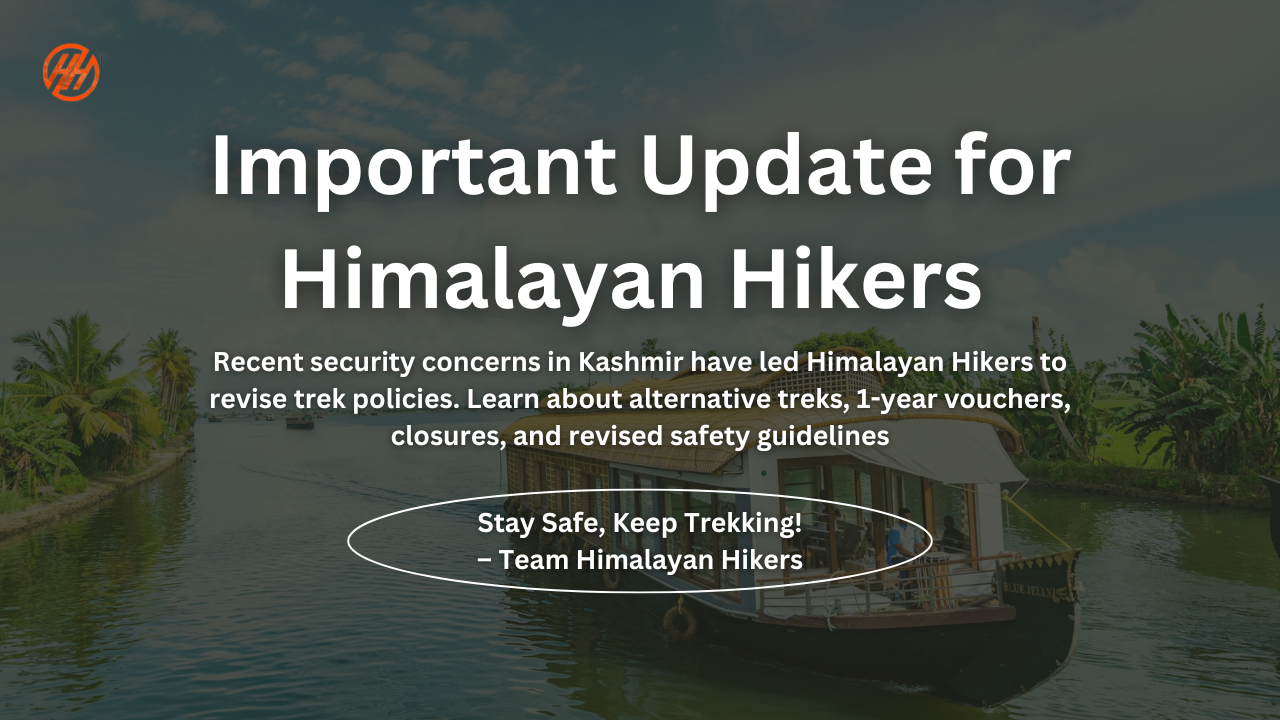
Important Update for Himalayan Hikers | Policy Revisions Due to Kashmir Security Situation
Important Update on Kashmir Treks Lakes
The Himalayan Hikers team deeply regrets the recent terror attack in Kashmir on 23 April 2025, which has compelled us to prioritize the safety of our trekkers and staff. After careful deliberation, we are revising our policies for treks in the Kashmir region. Below are the critical updates:
Key Policy Changes Effective Immediately
- Cancellation Not Permitted
Due to unforeseen circumstances, Cancellations for Kashmir Treks will no longer be available. - Alternative Treks Offered
Trekkers can option for these equally stunning Himalayan adventures:
- Pin Bhaba Pass Trek (Himachal Pradesh)
- Kashmir Great Lake Trek (Kashmir )
- Hampta Pass Trek (Himachal Pradesh)
- Valley of Flowers Trek (Uttarakhand)
- Buran Ghati Trek (Himachal Pradesh)
- Phulara Ridge Trek (Uttarakhand)
- 1-Year Voucher Option
- If alternative treks don’t suit your schedule, claim a Transferable Voucher valid for 12 months.
- The voucher amount can be adjusted against any future trek. If the new trek costs less, the balance will remain valid for later use.
- Tarsar Marsar Trek Closure
The Tarsar Marsar trek will remain closed until 10 August 2025 due to safety reassessments.
Why Are These Changes Necessary?
Here are the 10 reasons behind our revised policies:
- Safety First: Recent attacks demand heightened caution in conflict-prone zones.
- Logistical Challenges: Last-minute cancellations disrupt team planning and local partnerships.
- Financial Sustainability: Supporting guides, vendors, and staff during uncertain times.
- Commitment to Alternatives: Offering equally breathtaking treks outside Kashmir.
- Voucher Flexibility: Ensuring trekkers retain their investment for future adventures.
- Avoiding Stranded Resources: Pre-booked permits, accommodations, and logistics cannot be refunded.
- Operational Continuity: Keeping Himalayan Hikers functional for all trekkers.
- Government Advisories: Aligning with official security guidelines for Kashmir.
- Minimizing Losses: Balancing trekkers’ interests and organizational viability.
- Long-Term Trust: Upholding our promise to deliver safe, memorable experiences.
How to Proceed If You’re Affected
- Choose an Alternative Trek: Contact us to switch to Pin bhaba Pass, Hampta Pass, or other listed treks.
- Claim Your Voucher: Email us at himalayanhikers.dun@gmail.com to request a voucher.
- Stay Updated: Follow our website/social media for real-time updates on Kashmir treks.

7 Reasons Why the Kashmir Great Lakes (KGL) Trek Is Safe in 2025
Despite the recent security situation in Kashmir, the Kashmir Great Lakes (KGL) trek remains operational with stringent safety measures. Below are 10 critical points explaining why this iconic trek is still safe, along with details about the Pahalgam-to-KGL route and how it differs from other trails:
1. Strict Route Selection: Pahalgam to KGL Path
- Kashmir Great Lakes trek does not follow the Pahalgam route, and it is far from conflict-prone zones.
- Unlike the Sonamarg or Srinagar routes, this trail is protected with multiple army checkposts and closely monitored by local authorities.
2. Real-Time Government Clearance
- The KGL trek operates only after daily approvals from the J&K Tourism Department and security forces.
- No batch proceeds without explicit green signals.
3. Restricted Access to Sensitive Areas
- The route avoids villages or zones flagged as sensitive post-April 2025.
- Campsites are set up in secure, open meadows with clear visibility (e.g., Vishansar Lake, Gadsar).
4. Military Checkpoints
- The trail has 3 checkpoints (Pahalgam, Aru, and Gadsar) where trekkers’ identities and permits are verified.
5. Communication & Emergency Protocols
- Satellite phones and walkie-talkies are carried by guides for instant communication.
- Emergency evacuation plans are pre-coordinated with the Indian Army’s nearby units.
6. Focus on High-Altitude Sections
- The trek’s riskiest sections (e.g., Gadsar Pass) are above 13,000 ft, far from human settlements and conflict areas.
7. Community Collaboration
- Himalayan Hikers work closely with Pahadi communities in Pahalgam and Aru Valley, who act as local informants for any security concerns.
Kashmir Great Lakes Trek Route: How It Differs from Other Paths
- Safer Starting Point: Begins in Sonamarg (peaceful area) instead of Pahalgam (closer to recent incidents).
- Lower Footfall: Fewer crowds mean minimal attention from external elements.
- Military Presence: Army camps dot the route from Srinagar to Shitkadi, Sonamarg.
- Controlled Access: Only registered trekkers with permits are allowed Kashmir Great Lakes trek route.
- Scenic Isolation: The trail traverses remote alpine zones, reducing interaction with non-trekking populations.
Final Note
While we understand the inconvenience caused, these steps are vital to ensure safety and operational resilience. The Himalayas have countless trails to explore, and we’re committed to guiding you through them. Thank you for standing with us as we navigate these challenging times.
Stay Safe, Keep Trekking!
– Team Himalayan Hikers
